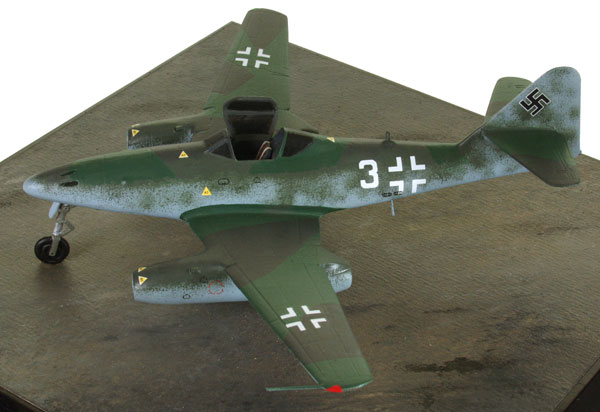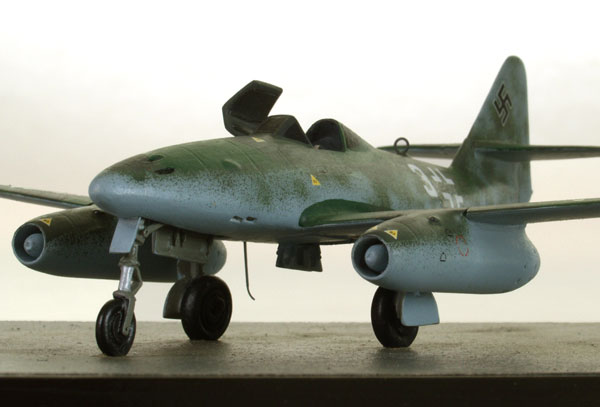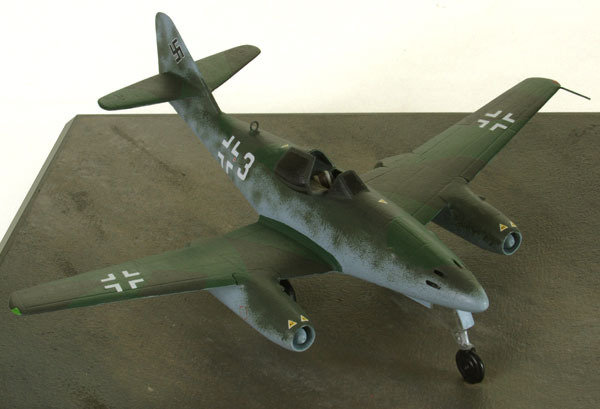Messerschmitt Me 262A-1a
Messerschmitt Me 262A-1a ‘White 3’
Jagdverband 44 Generalleutnant Adolf Galland, Munich-Riem, April 1945.
The Messerschmitt Me 262A-1a was the first jet fighter to see air-to-air combat; Jagdverband 44 was an almost impromptu assembly of Luftwaffe fighter Experten. The two came together in the final months of World War II, and have become the stuff of legend. The Messerschmitt Me 262 programme was underway in 1940, but problems with the development of jet engines resulted in its introduction to service being in 1944. Conceived as an interceptor, there was more delay in implementing this role fully while it was adapted for ground attack tasks, prompted by the Allied invasion of Europe, and it served with trials units with mixed operational success while establishing new techniques and tactics. After a four month delay the first full fighter Geschwader, JG7, was established in November 1944, to be led by the Kommodore, appointed by General der Jagdflieger Adolf Galland, Oberst Johannes Steinhoff. Around this time considerable unrest among a number of more experienced fighter pilots resulted in a meeting of a group of them in Berlin that was seen as being almost a mutiny; as a consequence, several of those who were known to have taken part were appointed to other posts and Reichsmarschall Goering, expressing dissatisfaction with the performance of the fighter arm, dismissed Galland from his post.
In January Adolf Hitler required to know why the jet fighter was not achieving the expected results in the interception of Allied bombers, and as a result of his intervention Galland was tasked with changing this state of affairs with a dedicated unit, substantially independent of the Luftwaffe command structure. Given the title Jagdverband 44, it gradually assembled a number of aircraft, some already in service and some fresh from a production line, from a variety of sources, and staffed it in much the same way either from personal knowledge of pilots’ capabilities or through recommendation. Several of those connected with, or on the fringe of, the November meeting joined him, notably “Macki” Steinhoff and Gunter Lutzow, and the unit was formed at Brandenburg-Briest in February 1945.
White 3 was a standard Messerschmitt Me 262A-1a, with four 30.mm cannon, and many of this variant also had the capability to carry twenty four R4M air-to-air rockets; the purpose of these was to break up bomber formations from a longer range than that needed for cannon use, and JV44 used this weapon and tactic to some effect. This aircraft was almost anonymous, not carrying any rank markings, or indeed anything beyond the plain number; there appears to have been no unit badge for JV44, though one – perhaps jealous – non-member remarked that it could well have been a “Knight’s Cross”. While the aircraft were in a variety of finishes that of White 3 was the familiar green mottle over grey/blue, and with the varying number of serviceable aircraft available it was flown by others as well as the Generalleutnant. Galland himself was wounded in the knee in an engagement with B-26 Marauders on 26 April, and did not fly again in the war. By the end of the conflict JV44, belatedly assigned as part of JG7, had moved most of its aircraft to Salzburg where under the direction of Heinz Bar and Walter Krupinski many were disabled in the face of the imminent arrival of advancing American ground troops. A number of Messerschmitt Me 262A-1as were taken over by the Allies, with a few flight-tested in France, America and Great Britain; and several of the Aces gathered in JV44 were to take a leading part in establishing the post-war Luftwaffe.
Scale 1:72 Wingspan 6.84″ (174 mm)
Base size 7.71″ (196 mm) square (No. 5)
Weight not including base 12 ozs (337 grams)
Limited edition of 25 only
SOLD OUT




